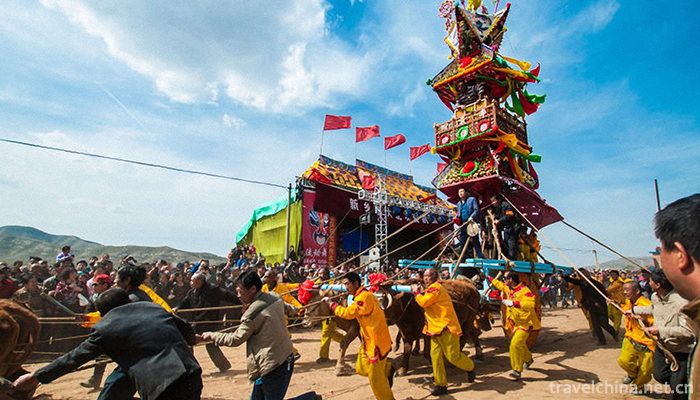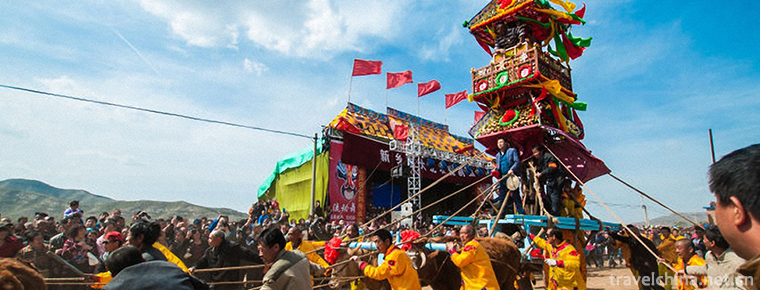Four Scenic Car Race
Four Scenic Car Race
Duyuan Sijing Car Race is a folk activity in Pingshun County, Shanxi Province. In May 2011, Pingshun County, Shanxi Province declared the "Four Scenic Car Race with a single Yuan" and was approved by the State Council to be included in the third batch of national intangible cultural heritage list.
historical origin
The Four Scenic Vehicles originated from the local nine-day Temple Fair of Notre Dame.
The Nine-day Notre Dame Temple is located in Donghe Village in the east of Shexiang, northwest of Pingshun County. It belongs to the Song Dynasty architecture. It has been 904 years since then, and is a key cultural relic protection unit at the national level. The Nine Days Notre Dame Temple has a great influence in the local area, especially the grand ancient temple fair held in March every year, which is the most popular event for the local people to participate in. There are many kinds of folk societies in the meeting, including four scenic cars, 24 social buildings, 2 divine driving, 24 divine horses, lifting bars, newspaper decorations (colorful children), stilts, stilts, social drums, folk bands, pedestrian bands, Temple party bands, dress-carrying, Shen banner, brand, umbrella, silver umbrella, curved driving, etc. Have everything that one expects to find. Among these social fires, Sijing Car is the most spectacular spectacle.
The Ancient Temple Fair is called the Grand Competition, also known as the Sporting Car Fair. Its content is mainly the display of folk arts and crafts and folk performing arts. The origin of the competition can not be ascertained. According to the frame design and body shape of Sijing Car, experts infer that it was originated in the Ming Dynasty. According to relevant experts, the Temple Fair of the Nine-day Notre-Dame is the sacrificial ceremony of the Nine-day Notre-Dame, while the Four-Scenic Car is the stick cart in the sacrificial activities.
In the Xianfeng period of the Qing Dynasty, Mr. Kui Lao wrote poems in praise: "Four Kingdoms and Magic Cars are countless years, eight villages and five societies spread, Sai Dynasty routine divination three spring curtain, feast wine first taste February day. After twenty-four horse towers, several clubs inspired the present. It flows from east to South and west, worshipping Danxiao Taiyixian.
After the outbreak of the War of Resistance Against Japan, the smoke of the battlefield was also scattered here. There was no day in the world, and the people were bored. The annual nine-day Notre Dame Temple Competition would be interrupted. In the decades since then, people have never seen the shadow of the Four Scenic Vehicles. Until the Spring Festival of 1985, in order to promote national culture, inherit and save folk cultural heritage, and comply with public opinion, the Beishe Village Committee duplicated the four scenic cars as before for villagers to enjoy during the festival.
On the fourth day of April in the lunar calendar of 2005, the Nine-day Notre Dame Temple Competition resumed for 66 years, and the Four Views Car Competition met the world again.
Folk activities
Four scenic cars are divided into three sections from bottom to top. The first section is a carriage, 1.5 meters high, 6.8 meters long and 1.8 meters wide; the second section is a basin, flat square, 3.6 meters high and 1.7 meters wide; the third section is a building, 6.8 meters high, decorated pheasant feathers 1.5 meters high. The car is about 13 meters high and 1.7 meters wide. Wooden frame for vehicle body. The first and second sections are hand-tied with coloured silk and coloured paper for decoration and opening to traffic.
The so-called "Four Sceneries" of Sijing Car is not the four scenic spots of the car itself, but the ingenious design of the structure of the car itself.
One is a single tree with two big healthy cattle.
Secondly, a horn rod and three calf rings are used to support the pole.
The third section is the main timber frame of the second section, which is erected on the bottom plate without mortise and tenon, and fastened with hemp rope up and down;
Fourth, the upper end of the second main timber frame and the lower end of the third main timber frame are joined together, instead of having to fasten the mortise or tenon, four hemp ropes are tied up and fixed up. In addition to the pulling power of two yaks and two shooting cattle, the front of the car is pulled by nearly 100 strong laborers with two hemp ropes about 5 cm in diameter, and there are four ropes in the back and left and right of the car to prevent the body from tilting and tipping.
Four Scenic Vehicles are about 5 kilometers away from the Nine-day Notre Dame Temple of the East River to the main venue (the center of the circle). In the middle, they also pass through a soil slope of about 50 meters and 45 degrees. Their distance is far, and the steep slope brings some difficulties to the sports car.
Inheritance significance
Sijing Car carries the wisdom and wisdom of the local working people for thousands of years. It contains rich traditional cultural achievements. It is a festive artistic product for the people to celebrate the prosperous times of peace, good weather and abundant grain.
Because of the peculiar four sceneries, there are many visitors along the way. Whether they have participated in the contest or watched the four sceneries car has become a qualification and an honor for the local people. Therefore, the proverb "catch up with the competition, die without regret" is still popular among the people.


-
1.The Temple House Bo she Hotel
Located in Chengdu, the Bosch is a luxury hotel with a unique style, which combines the beauty of traditional and modern design. The shape design is charming and energetic, reflecting the city's legen
Time 2018-12-16 -
2.Yunpu Dongtian Tourist Area
Yimeng Yunpu Cave Tianshan Scenic Area is located in Feixian County, Shandong Province. There are five scenic spots: Tour Stone, Tianmeng Lake, Drunken Stone Forest
Time 2018-12-22 -
3.Blue Moon Bay Hot Spring Resort
Lanyuewan Hot Spring Resort is the largest four-star garden-style foreign-related hotel and national AAAA-level tourist scenic spot in Western Guangdong. It is located in the quiet "Guangzhou Bay
Time 2019-01-29 -
4.Eco health Tourism Resort in Sishui Shandong Province
"Shandong Sishui Violent Eco-health Tourism Resort" is a pioneer in China, which combines superior ecological environment, long-standing health culture and modern leisure and vacation indust
Time 2019-02-13 -
5.Tanxi Mountain Scenic Area
Tanxi Mountain Tourist Area: National AAAA Tourist Area, National Forest Park, National Geopark, National Water Conservancy Scenic Area and Key Scenic Spots in Shandong Province.
Time 2019-02-13 -
6.Kirgiz Kumzi Art
Kumzi is an ancient plucked instrument unique to the Kirgiz people. The meaning of "Kumzi" Kirgiz people is "beautiful musical instrument". Mainly spread in Xinjiang Kirgiz Autonom
Time 2019-05-09 -
7.Mongolian Long tune Folk Songs
Mongolian long-tune Mongolian is called "Uri Tudao", which means long song. It is characterized by fewer words, long-lasting, soothing and free, suitable for narration, and longer lyric.
Time 2019-06-04 -
8.Tajik costumes
Tajik costume refers to the costume with distinct ethnic characteristics of Tajik. Tajik people mainly live in the Pamir Plateau with cold climate. Their economic life is mainly animal husbandry and a
Time 2019-06-17 -
9.Yao Opera
Yao Opera is popular in Yuyao, Cixi, Ningbo, Zhoushan, Shangyu and Shaoxing. It developed on the basis of folk singing and dancing "horse lantern", "dry boat" and "tea basket&
Time 2019-07-11 -
10.Empress Dowager Ci Xi
Ci Xi (November 29, 1835 - November 15, 1908) is the queen of Xiao Qin chin. Yehiel Bernard La Shi, Xianfeng Emperor Concubines, Tongzhi Emperor The birth mother. Important in late Qing Dynasty Politi
Time 2019-09-07 -
11.Sausages with cuttlefish
Cuttlefish, also known as cuttlefish, squid. Cuttlefish is delicious, nutritious and of high medicinal value. It is rich in protein, fat, inorganic salt, carbohydrate and many other substances. In add
Time 2020-04-10 -
12.Erwang Temple
The Erwangmiao ancient building complex is located at the foot of Yulei mountain outside the west gate of today's Dujiangyan, which is an important part of the world cultural heritage Dujiangyan. The temple was built in memory of Li Bing and his son Erlang. The Erwang temple was first built in the northern and Southern Dynasties
Time 2020-11-08